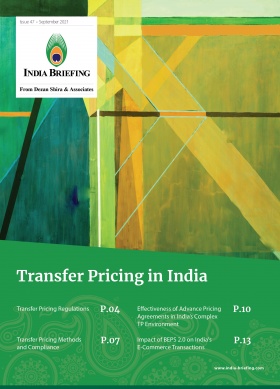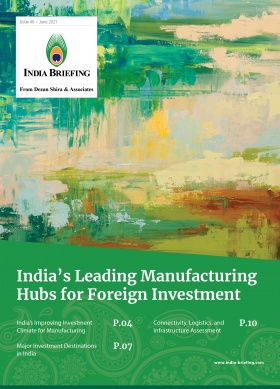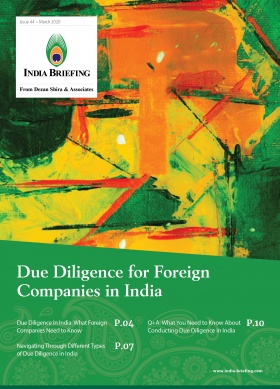India-South Korea Trade and Investment: Trends and Opportunities
We profile India-South Korea trade and investment flows, key investors and traded products, and opportunities for Korean manufacturing investments in India.
India-South Korea relations have made great strides in recent years. Bilateral cooperation covers a range of sectors, including energy, electronics, shipbuilding, information technology, cybersecurity, etc. Spurred by significant convergence of interests, both India and South Korea have been working on integrating the goals of India’s “Act East Policy” and South Korea’s “New Southern Policy”. In the same pursuit, both sides have committed to further strengthen the India-South Korea Comprehensive Economic Partnership Agreement (CEPA) to bridge India’s high trade deficit with the country.
India and South Korea have also agreed to foster cooperation on the energy, electronics and shipbuilding industries. A joint working group for cooperation on the shipbuilding sector and another such working group in the field of electronics hardware manufacturing have been set up. South Korea has offered US$10 billion in financing for development assistance and concessional credit to India for infrastructure projects.
At present, South Korea is the 13th largest foreign direct investment (FDI) source in India, investing US$4.97 billion between April 2000 to June 2021, led by companies like Tata Daewoo, Ssangyong, and Novelis. Between April-December 2020, India’s export basket to South Korea, valued at US$3.27 billion, was dominated by aluminum ingots, telephone parts, integrated circuits and personal computers. During the same period, imports from South Korea stood at US$8.49 billion, comprising electronic components, plastic raw materials, and iron and steel products.
South Korea’s economic profile
The Republic of Korea is in eastern Asia and is the southern half of the Korean Peninsula. South Korea’s economic success has been driven by a robust export-based economic model. The country has developed considerable expertise in shipbuilding, steel, nuclear energy, heavy electrical machinery, etc. and its global export basket is dominated by high-tech manufactured products like semiconductors, machinery, automobiles, ships, LCD, and wireless communication devices. It has world’s largest shipbuilding industry and ranks among the top producers of semiconductors and electronic products. A major auto manufacturer, Korea produces over 4.5 million vehicles annually.
As of 2020, South Korea’s GDP stood at US$1.6 trillion with services (62.4 percent) claiming the maximum contribution to the country’s GDP, followed by manufacturing (27.7 percent), construction (6 percent), electricity, gas and water supply (2.1 percent), and agriculture (1.8 percent). This economic transformation has been achieved despite South Korea’s high dependence on import of natural resources, including crude oil and essential minerals.
South Korea’s major export partners are China, member countries of the Association of Southeast Asian Nations (ASEAN), United States (US), European Union (EU), Japan, India, Brazil, and Paraguay. South Korea imports mainly oil, semiconductors and natural gas, coal, steel and iron ore, with top import partners being China, Japan, US, Saudi Arabia, EU, member states of ASEAN, and Australia.
Bilateral economic ties between India and South Korea
South’s Korea’s export-led economy sees considerable opportunity in India’s large untapped markets, which are no stranger to the famous “K-Wave (Hallyu)” that has influenced consumer tastes and preferences worldwide, including India, with respect to personal care, food, entertainment, and the fashion industries. Both countries have set a target to achieve bilateral trade worth US$50 billion by 2030. South Korea seeks India’s prowess in IT software and intends to synergize it with its expertise in IT hardware, designing, engineering, and manufacturing. To expand access into South Korean markets, India must work towards diversifying its export basket, specifically focusing on high-tech products in addition to primary goods.
India and South Korea have been working closely towards exploring commercial opportunities in space, defense, and nuclear energy areas, while at the same time working towards deepening their “Special Strategic Partnership”. The two countries recently concluded their third India-Republic of Korea Strategic Dialogue where both sides agreed to further bolster and expand mutually beneficial strategic cooperation in areas of bilateral, regional, and global interest.
Additionally, as a step towards facilitating better economic cooperation, the ‘Korea Plus’ desk has been created as a single window in India to address all the issues raised by South Korean companies in India. In 2019, the ‘India-Korea Startup Hub’ was inaugurated by Indian Prime Minister Narendra Modi to increase cooperation in areas of research, innovation, and entrepreneurship.
On December 8, 2021, Noida city (Uttar Pradesh state) signed an MoU with the South Korean city of Changwon (South Gyeongsang province) for economic development through cooperative schemes between the two cities.
Prior to that, in August 2021, South Korean food company Orion invested INR 2000 million (US$26.90 million) to set up a manufacturing facility at Bhiwadi city in the north Indian state of Rajasthan.
India-South Korea Comprehensive Economic Partnership Agreement (CEPA)
India and South Korea signed their Comprehensive Economic Partnership Agreement in Seoul on August 7, 2009. CEPA was operationalized from January 1, 2010. The trade deal committed both countries to lowering or eliminating import tariffs on a wide range of goods over eight years. Overall, the agreement has helped expand opportunities for investments and trade in goods and services. As part of the pact, while South Korea was to phase out or reduce tariffs on 90 percent of Indian exports, India committed to eliminate or reduce tariffs on 85 percent of Korean exports.
Furthermore, CEPA between the countries has also led to the opening up of the services sector. In sectors like telecommunications, accounting, building, construction, real estate, distribution (retail excluded), real estate, transportation, industrial, and energy distribution, etc. In the financial services sector, 10 South Korean banks have been permitted to establish branches in India. Presently, Shinhan Bank has four branches, Woori Bank and KB bank has one branch each in India, while the Hana Bank have set up their representative offices in India.
In 2015, during a summit meeting in 2015, India and South Korea started the process to review CEPA, with an aim to comprehensively upgrade the agreement to achieve full potential of the strategic partnership and work towards attaining parity in terms of trade balance. For instance, barriers that India faces with respect to South Korea’s restrictive policy towards import of primary agricultural products, such as fruits and vegetables, is one issue that needs to be addressed in the CEPA review meet. Moreover, issues regarding diversification of the export products, which are at present dominated by petrochemical products, mainly Naphtha, also needs to be addressed.
India’s exports to South Korea
The major items that constitute the bulk of exports from India to South Korea are mineral fuels/oil distillates (mainly naphtha with 20 percent share), cereals, iron and steel. In 2019, Indian exports to South Korea were valued at US$5.56 billion. The main products exported from India to South Korea were refined petroleum (US$988 million), raw aluminum (US$795 million), and ferroalloys (US$229 million). During the last 24 years, Indian exports to South Korea have increased at an annual rate of 7.95 percent, from US$809 million in 1995 to US$5.56 billion in 2019. In 2020, this value slumped to US$4,9 billion, induced by COVID-19 pandemic led restrictions.
India’s imports from South Korea
The main products that India imports from South Korea include automobile parts, telecommunication equipment, hot rolled iron products, petroleum refined products, base lubricating oils, nuclear reactors, mechanical appliances, electrical machinery & parts, and iron & steel products. In 2019, South Korea exports to India were worth US$15.09 billion. South Korea’s main exports to India were integrated circuits (US$1.43 billion), vehicle parts (US$925 million), and hot-rolled iron (US$858 million). During the last 24 years, South Korean exports to India have increased at an annualized rate of 11.2 percent, from US$1.21 billion in 1995 to US$15.09 billion in 2019. In 2020, this figure stood at US$11.95 billion.
|
India-Republic of Korea (South Korea) Bilateral Trade (US$ Millions) |
||||||
|
Year |
Total trade |
Growth (in percentage) |
Indian exports to South Korea |
Growth (in percentage) |
South Korea exports to India |
Growth (in percentage) |
|
2007 |
11,224 |
22.35% |
4,624 |
27.03% |
6,600 |
19.3% |
|
2008 |
15,558 |
39.00% |
6,581 |
42.32% |
8,977 |
36% |
|
2009 |
12,155 |
-21.88% |
4,142 |
-37.06% |
8,013 |
-10.7% |
|
2010 |
17,109 |
40.76% |
5,674 |
36.98% |
11,435 |
42.7% |
|
2011 |
20,548 |
20.10% |
7,894 |
39% |
12,654 |
10.7% |
|
2012 |
18,843 |
-8.30% |
6,921 |
-12.3% |
11,922 |
-5.8% |
|
2013 |
17,568 |
-0.07% |
6,183 |
-10.7 % |
11,385 |
-4.5% |
|
2014 |
18,060 |
2.8% |
5,275 |
-14.6% |
12,785 |
12.4% |
|
2015 |
16,271 |
-9.9% |
4,241 |
-19.6% |
12,030 |
-5.9% |
|
2016 |
15,785 |
-2.9% |
4,189 |
-1.2% |
11,596 |
-3.6% |
|
2017 |
20,005 |
26.7% |
4,949 |
18.1% |
15,056 |
29.8% |
|
2018 |
21,491 |
7.4% |
5,885 |
18.9% |
15,606 |
3.7% |
|
2019 |
20,663 |
-3.87% |
5,566 |
-5.40% |
15,097 |
-3.29% |
|
2020 |
16,852 |
-22.61% |
4,900 |
-12.0% |
11,952 |
-20.8% |
South Korean investments in India
According to the Korea Trade Investment Promotion Agency (KOTRA), about 88 percent of all South Korean subsidiaries established in India are wholly owned while approximately 11.3 percent are joint ventures. Korean enterprises, including Hyundai Motors, LG, and Samsung decided to set up wholly owned subsidiaries with large scale investments, allowing them to leverage economies of scale along with establishing their brand image at an early stage. This also enabled them to gain negotiating power with local governments in India.
South Korea’s investment in India in the first quarter of 2021 (January-March) was valued at US$96 million, according to data from the Export-Import Bank of Korea (Korea EXIM Bank). In 2020, South Korea’s investment in India reached US$396 million.
14 new South Korean corporations were established in India in the first quarter of 2021. In 2020, Korea’s investment in India stood at US$51.9 billion, registering a 16 percent increase over the previous year’s US$44.7 billion. 66 new South Korean corporations were established in India in 2020. This volume of investment could be connected to the Indian government’s Production Linked Incentive (PLI) schemes announced for several sectors.
In particular, the inflow of funds from large Korean corporations, such as Samsung, accounted for 57.2 percent of the total investment. According to statistics from KOTRA and Korean Exim Bank, Korean investment in India is concentrated mainly in the manufacturing sectors, followed by wholesale and retail trade, financial and insurance activities, and electricity, gas, steam and water supply. Major centers of investment are National Capital Region or NCR (cities of Delhi, Noida, and Gurgaon), Chennai (Tamil Nadu), and Mumbai and Pune (Maharashtra).
Among Korean companies that have invested in India, Hyundai Motor Group, Samsung Electronics, and LG Group lead the bunch. Other important Korean companies with a sizeable presence in the Indian market include Hyundai Motors and Kia Motors.
|
Republic of Korea (South Korea) Foreign Direct Investment (FDI) in India |
|||||||||
|
Year |
2013 |
2014 |
2015 |
2016 |
2017 |
2018 |
2019 |
2020 |
Total |
|
No. of Registration |
190 |
160 |
264 |
268 |
308 |
408 |
451 |
220 |
4,133 |
|
No. of New Companies |
41 |
39 |
55 |
55 |
113 |
119 |
131 |
66 |
1,292 |
|
Investment |
US$573 million |
US$387 million |
US$390 billion |
US$382 million |
US$949 billion |
US$827 million |
US$685 million |
US$396 million |
US$8,802 million |
|
Actual Investment |
US$347 million |
US$337 million |
US$365 million |
US$337 million |
US$516 million |
US$1,072 million |
US$447 million |
US$519 million |
US$6,943 million |
Indian investments in South Korea
While India’s investment in Korea has been slow since 2013, its investment in 2019 recorded US$96.66 million, marking a huge surge from US$2 million in 2018. However, it again fell to US$1.43 million in 2020. Some major Indian investors in South Korea are Novelis Inc., a subsidiary of Hindalco Industries Ltd, Tata Motors Limited, Mahindra and Mahindra, and Nakhoda Ltd etc. Tata Motors Limited acquired Daewoo Commercial Vehicle, which is based in Gunsan, South Korea in 2004 and its cumulative investment in South Korea now stands at over US$400 million.
|
Indian Foreign Direct Investment (FDI) in Republic of Korea (South Korea) |
|||||||||
|
Year |
2013 |
2014 |
2015 |
2016 |
2017 |
2018 |
2019 |
2020 |
Total |
|
No. of Registration |
23 |
9 |
10 |
6 |
11 |
13 |
16 |
12 |
696 |
|
Investment |
US$98.7 million |
US$1.6 million |
US$2.5 million |
US$1.4 million |
US$1.7 million |
US$2.0 million |
US$96.6 million |
US$1.43 million |
US$ 677 million |
About Us
India Briefing is produced by Dezan Shira & Associates. The firm assists foreign investors throughout Asia from offices across the world, including in Delhi and Mumbai. Readers may write to india@dezshira.com for more support on doing business in in India.
We also maintain offices or have alliance partners assisting foreign investors in Indonesia, Singapore, Vietnam, Philippines, Malaysia, Thailand, Italy, Germany, and the United States, in addition to practices in Bangladesh and Russia.
- Previous Article All You Need to Know About Dividend Taxation in India
- Next Article An Introduction to Doing Business in India 2022 – New Publication from Dezan Shira & Associates








